Quentin Sommerville
Ukraine has drawn a line in the dirt, and that line is Bakhmut. It is a city that few say matters strategically, but that tens of thousands have died fighting over. It began more than seven months ago, and is the longest battle of the war so far.
Two Ukrainian army brigades defending the city's southern flank gave the BBC access to their positions last week as fierce fighting continued in and around Bakhmut. The men have spent months facing both regular Russian army forces, and prisoners recruited by the Wagner private military group who have swarmed their trenches in droves. Troops say Russian casualties far outweigh theirs, but the enemy is deploying new techniques to try to seize the city and surrounding countryside.
Ukraine's forces are outgunned and outnumbered, but on a chalk hillside to the south, there is the anti-tank group from the 3rd Separate Assault Brigade. 3Storm - as they are known - are unyielding. They've dug trenches deep into the earth. Timber props supporting the roof shudder as Russian artillery lands in the near distance, and field mice scurry along duck boards. An antiquated field telephone sits in a wooden nook; these are conditions their grandfathers would recognise.
"They cannot get to us, we can see for a kilometre in all directions," says a bearded 26-year-old soldier who goes by the call sign "Dwarf", pointing out Russian positions. "We can hit the enemy with everything we have," he says.
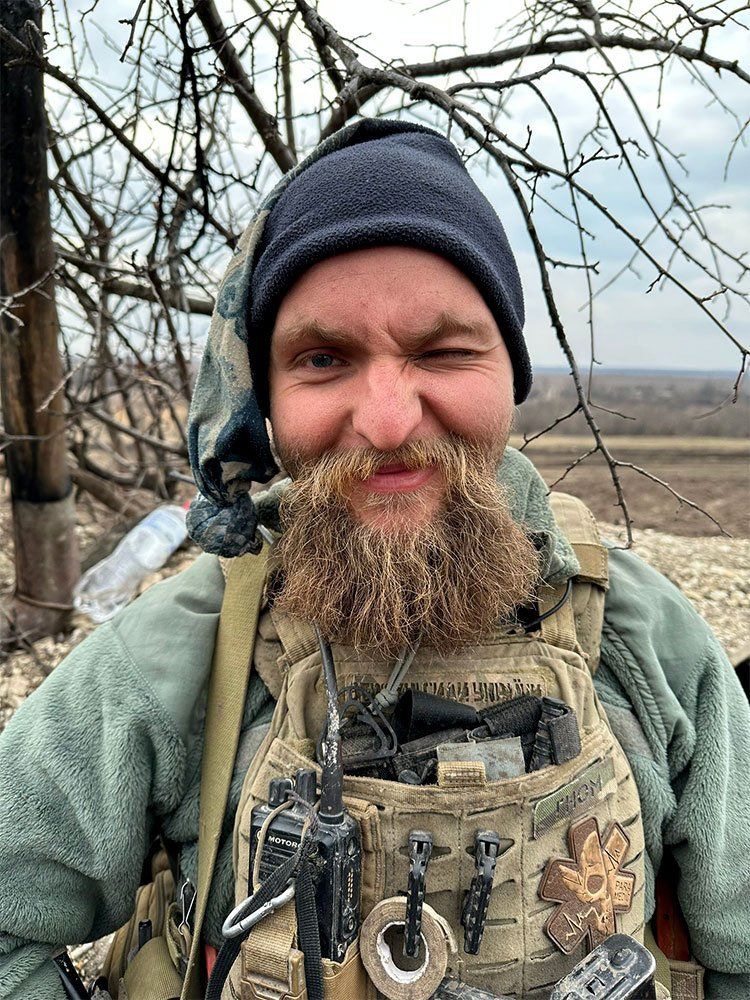
IMAGE SOURCE,QUENTIN SOMMERVILLE / BBCImage caption,
The 26-year-old goes by the call sign "Dwarf" as he's a big Lord of the Rings fan - although the name on the body armour actually translates as "Gnome"
Neither the Russian nor Ukrainian armies release official casualty figures for Bakhmut, or elsewhere, but the mostly abandoned city has become a slaughter house.
In a week fighting for the city, Dwarf's company faced conscripted prisoners from Russia's Wagner group. "We had battles every two hours," he says. "I guess a single company eliminated 50 people per day." In case of any doubt, he points out these numbers were confirmed by aerial reconnaissance. "The [Russian vehicle] arrives, 50 bodies come out, a day passes, 50 bodies come out again," he says. His company lost a fraction of that number, he says.
Officially, Ukraine estimates that for every one of its soldiers killed, Russia loses seven. Earlier this week, Russia said it had killed more than 220 Ukrainian service members in a 24-hour period in the battle for Bakhmut. None of these numbers can be independently verified.
In a newspaper interview, two captured Wagner conscripts told the Wall Street Journal that before they are sent forward, they receive little training beyond learning to crawl through forests in the dark. After six months serving at the front they are freed - assuming they survive.
Conditions all along the 600-mile-long eastern front have begun to change. 3Storm's chalky hilltop hideout feels like dry land compared with the surrounding territory. An early spring has turned the hard ground of winter to mud porridge - which may favour the defenders. To get there, we had to follow the Ukrainian soldiers on foot - within a few paces my boots become lumpen and heavy with thick dirt. A battlefield ambulance speeds by unsteadily, its caterpillar tracks ploughing up the ground, and spraying pools of sludge as it struggles for grip.
The villages around here - the location can't be revealed - are in ruin. Handwritten signs on gates, mostly in Russian, announce "People Live Here", a plea as much as it is a statement. But the streets are entirely empty, apart from abandoned dogs who roam the ruins of destroyed farms and homes.
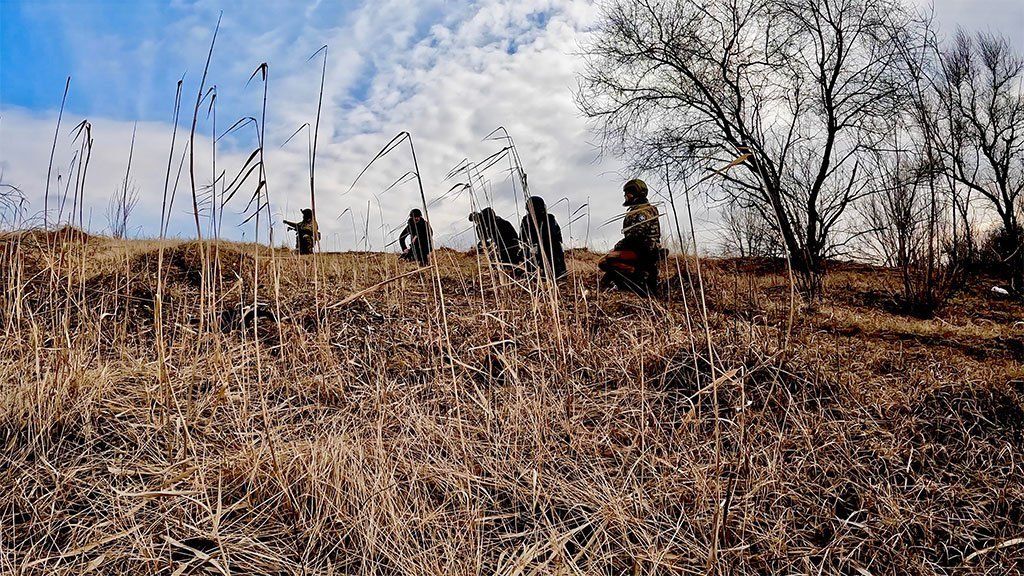 IMAGE SOURCE,STU HOLLAND/ BBCImage caption,
IMAGE SOURCE,STU HOLLAND/ BBCImage caption,Soldiers move through the tall grass
For the past two months, Russian forces have steadily advanced, trying to encircle Bakhmut. The commander of Ukrainian ground forces, General Oleksandr Syrsky, says his forces will continue to resist. "Every day of steadfast resistance wins us valuable time to reduce the enemy's offensive capabilities," he says, sending more reinforcements to the area. But it isn't only Russians who have fallen into the Bakhmut trap. Ukrainians are dying there, too, in ever increasing numbers.
On the hillside, a group of soldiers have gathered around a gun position, and I ask Dwarf - given that Ukraine is losing soldiers to untrained Russian convicts - if the defence of dead city, surrounded by the enemy, makes sense.
He says, "I was wondering, myself, if we should keep defending Bakhmut. On the one hand what's happening here now is awful. There are no words to describe it. But the alternative is we give up Bakhmut and move to another settlement. What's the difference between defending Bakhmut or any other village?"
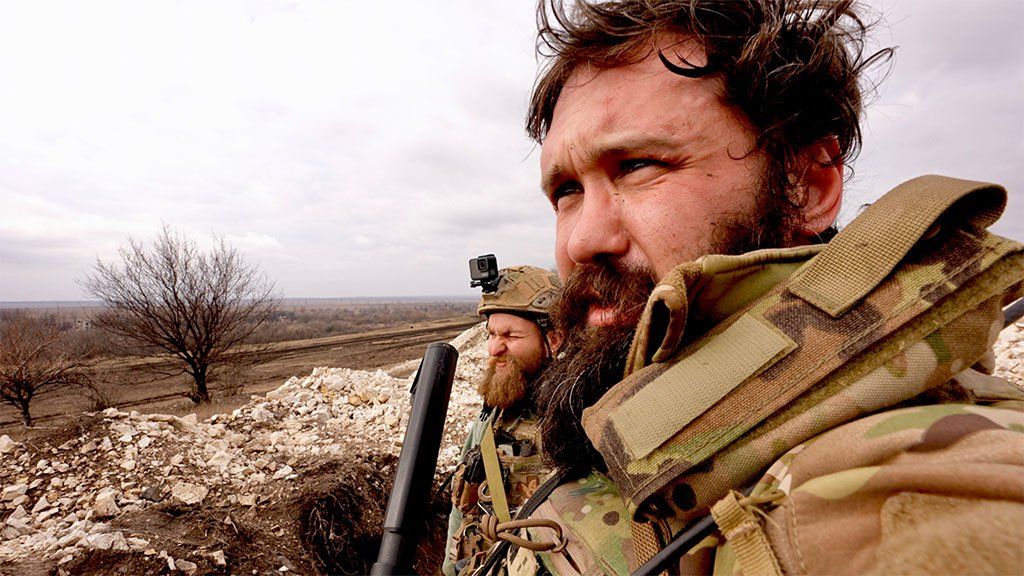 IMAGE SOURCE,DARREN CONWAY / BBCImage caption,
IMAGE SOURCE,DARREN CONWAY / BBCImage caption,"Dwarf" with his comrade "Holm"
His comrade, a strongly built man with a full dark beard who goes by the call sign Holm, agrees. "It's not a strategic question for us here. We are ordinary soldiers. But this is our land. We may then retreat to Chasiv Yar, from Chasiv Yar to Slovyansk, and so we retreat up to Kyiv. Let it take a year or two, four, five - but we have to fight for every piece of our land."
The men have been fighting for more than a year now, and they say the Russians are evolving.
"They are learning, they are getting cleverer, and it really freaks me out," says Dwarf. "They send out a group - five morons taken from prison. They are shot, but the enemy sees where you are, walks around, and you are surrounded from behind."
Holm chimes in that Russia is now using drones armed with grenades more effectively. "We used to drop them and freak them out," he says. "Now they're dropping drone grenades on our positions."
Before the war, Dwarf was an outdoor youth worker and would take youngsters hiking in the Carpathian Mountains on the country's western edge. Here on Ukraine's eastern front, that is a far-off memory. He's been in many battles since then, but the horror of Bakhmut is what lives with him now.
When I ask about Wagner's convict army, he pauses to think and says, "I'll be honest. It's genius. Cruel, immoral, but effective tactics. It worked out. And it's still working in Bakhmut."
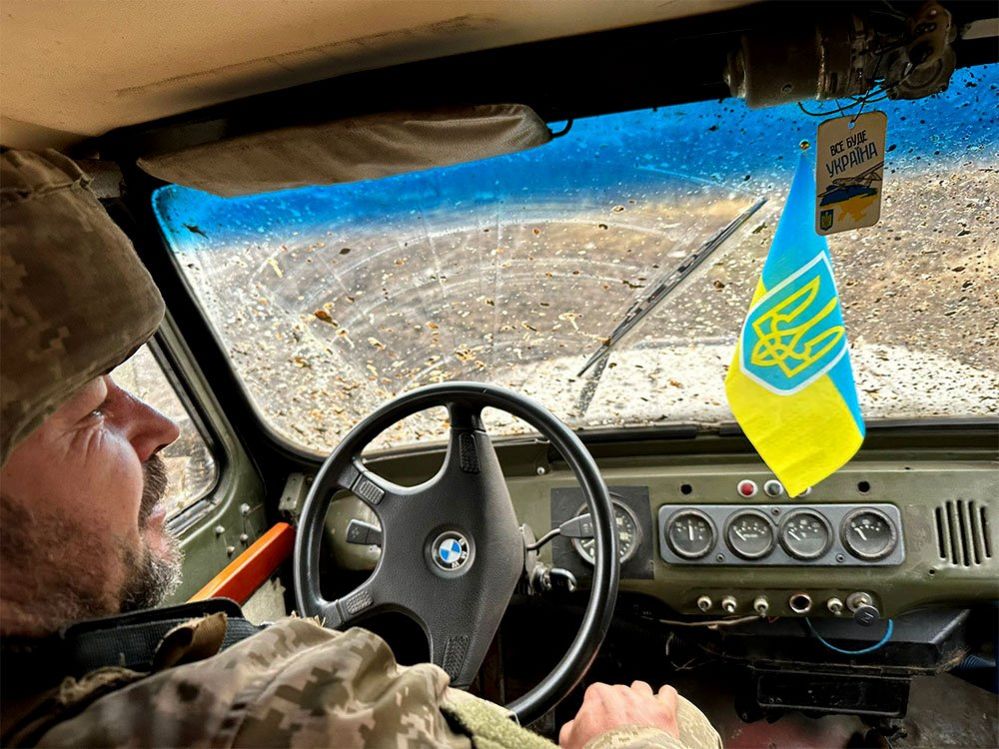 IMAGE SOURCE,QUENTIN SOMMERVILLE / BBCImage caption,
IMAGE SOURCE,QUENTIN SOMMERVILLE / BBCImage caption,Soviet-era UAZ jeep makes it way through the mud
Days later, I'm back in the same area, crammed with four others into a Soviet-era UAZ jeep. Its steering wheel has the BMW logo - a joke says the driver, Oleg. He says little else as he grips the wheel and concentrates hard as the car whines and struggles over hills and through the shoals of muck. The automatic gunfire ahead signals we are nearing the 28th Mechanised Brigade, who are directly facing the Russians.
The landscape of war shifts in an instant - the men are holed up in a small wood, its trees shattered and split by Russian fire. In a month, the wood will offer them cover. For now, its bare branches expose them to surveillance drones. Nearby there's an exchange of gunfire, and Russian shells strike around 500m away. But Borys, a 48-year-old former architect who is serving now as a captain, seems untroubled.
"Today's war is a drone war," he says, "but we can walk around freely, because there's wind and rain today and drones are blown away. If it was quiet today, both our drones and our enemy's would be hovering over us."
On the way back, Oleg brings the jeep to a sudden halt. Lying in the dirt in front of us is a drone that has been blown off course. Its battery is quickly removed and it is brought inside - it turns out to be Ukrainian.
But today's war isn't so very different from the past.
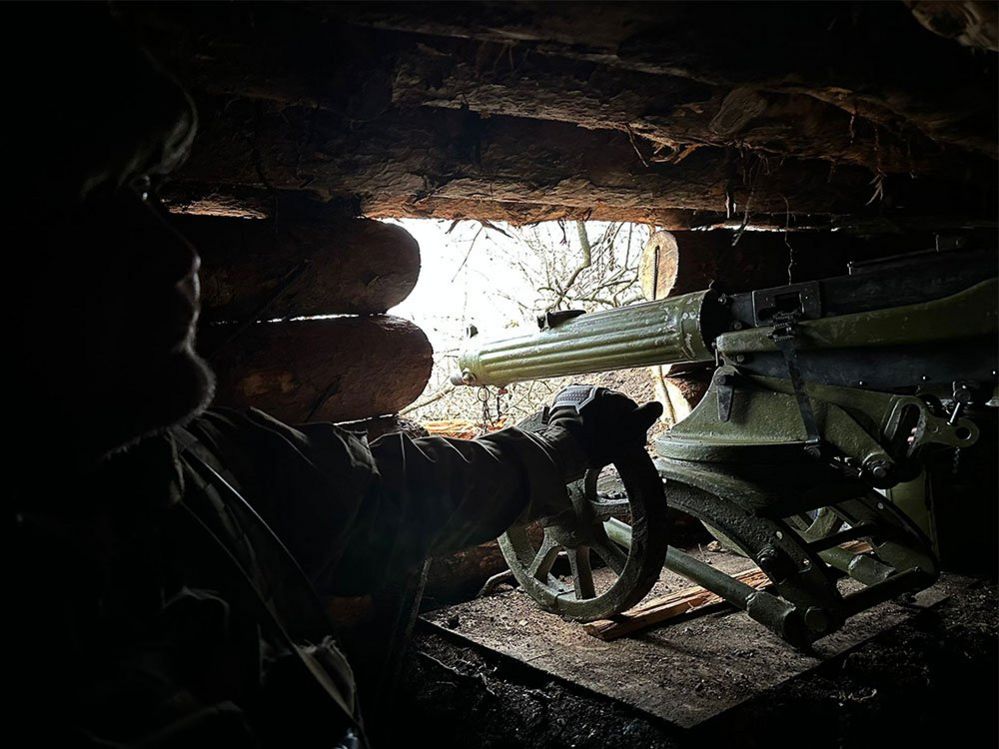 IMAGE SOURCE,QUENTIN SOMMERVILLE / BBCImage caption,
IMAGE SOURCE,QUENTIN SOMMERVILLE / BBCImage caption,Maxim machine gun
Two nights before, the 28th Brigade was attacked by Russian infantry and tanks. In a timbered gun position below ground, the cold rain drips through the roof onto the dirt floor, and there, peering out into the bare landscape, is a Maxim belt-fed machine gun with stout iron wheels.
"It only works when there is a massive attack going on…then it really works," says Borys. "So we use it every week".
And this is how the battle for Bakhmut is being fought, as winter turns to spring in 21st Century Europe. A 19th Century weapon still mows down men by the score in the black Ukrainian earth.
No comments:
Post a Comment